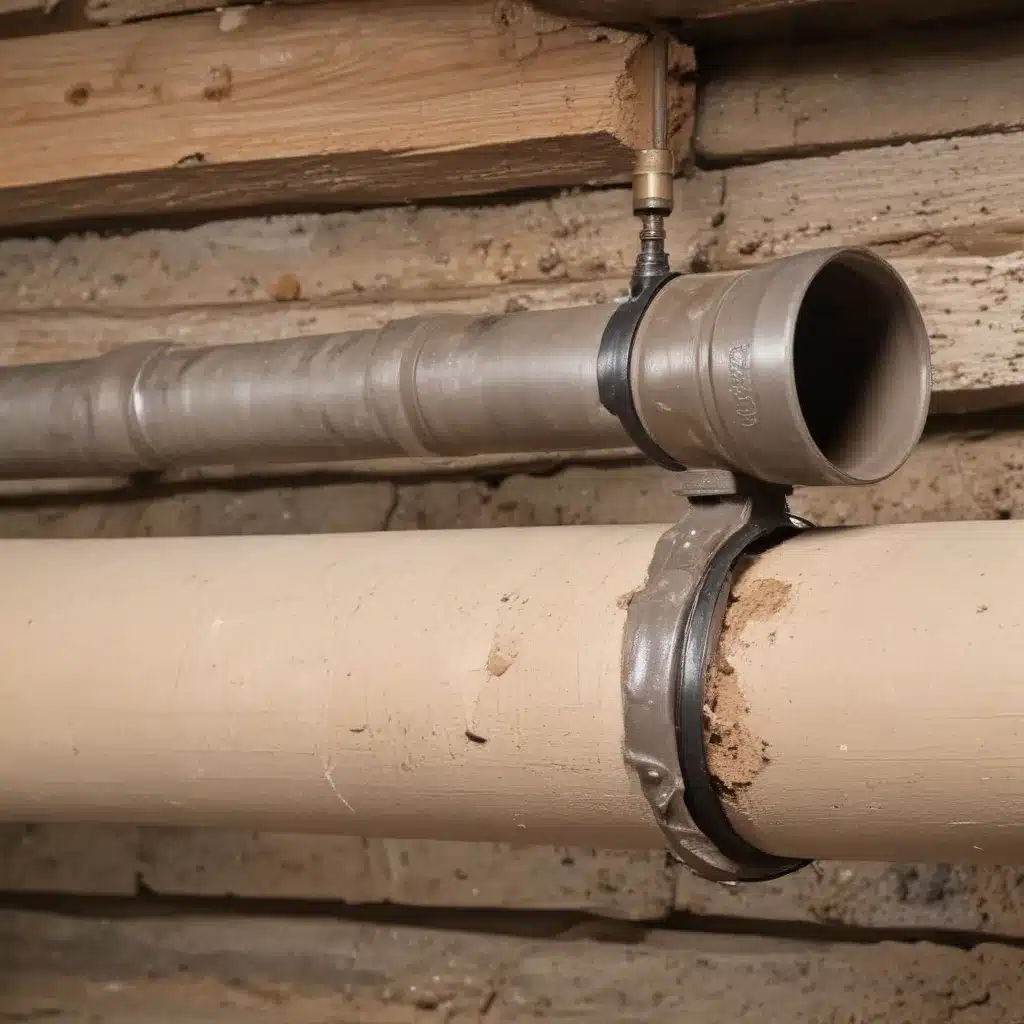
Plumbing and drainage systems in modern buildings require reliable, long-lasting pipe joints to prevent costly leaks and water damage. In our 15 years installing… As an experienced plumbing consultant for Plumbing Drains North Wales, I’ll explore the latest techniques for creating robust, leak-proof pipe connections that meet stringent performance and compliance standards.
Now, this might seem counterintuitive…
Mechanical Pipe Joints
Compression Fittings are a popular choice for quickly assembling pipes without specialized tools or high skill levels. These fittings use an internal compression ring or ferrule to create a seal against the pipe’s outer surface. Compression fittings work well for smaller-diameter pipes up to around 2 inches and can provide a reusable joint. However, they may not be as robust as other methods, and improper installation can lead to gradual leaks over time.
Push-to-Connect Fittings offer a fast, tool-free pipe connection solution. These fittings have an internal gripper ring and o-ring seal that tightly grips the pipe when pushed into place. Push-to-connect joints are simple to install, but their long-term reliability depends on maintaining a perfectly clean, scratch-free pipe end.
Threaded Pipe Joints utilize tapered male and female threads to create a seal. Threaded joints are reusable and easy to disassemble, making them suitable for applications that require frequent access, such as equipment connections. Proper thread sealant, careful alignment, and sufficient tightening are critical to prevent leaks.
Adhesive Pipe Joints
Solvent Cement Welding, also known as solvent welding, is a common technique for joining plastic pipes like PVC and CPVC. This process softens the pipe and fitting surfaces, allowing them to fuse together seamlessly. When done correctly, solvent welding provides a permanent, leak-proof joint that’s as strong as the pipe itself. Proper surface preparation, application of the right solvents, and a well-timed assembly are essential for a successful solvent-welded joint.
Epoxy Resin Bonding creates durable pipe connections by using a two-part epoxy adhesive. This method works well for joining dissimilar pipe materials, such as plastic-to-metal or plastic-to-ceramic. Epoxy bonds can withstand high pressures and harsh environments, but the application requires more skill and curing time compared to solvent welding.
Gasket Sealing utilizes a compressible gasket or o-ring to create a watertight seal between pipe sections or fittings. These joints are commonly found in larger-diameter plastic and metal piping systems. Gasket sealing allows for some movement and flexibility between connected pipes, but it’s crucial to select the right gasket material and double-check that proper compression during installation.
Leak Prevention Techniques
Proper pipe jointing methods are essential, but you might want to also consider water pressure management to minimize the risk of leaks in plumbing and drainage systems.
Pressure Regulation Devices, such as pressure-reducing valves, help maintain consistent water pressure throughout the distribution network. Maintaining optimal pressure levels reduces the strain on pipe joints and fittings, lowering the potential for leaks.
Surge Suppression Systems can absorb the sudden spikes in water pressure caused by rapid valve closures or pump starts/stops. These systems, which may include expansion tanks or hydraulic accumulators, help prevent joint failures due to water hammer.
Leak Detection Sensors can be strategically placed in critical locations to monitor for any unexpected water loss, allowing you to quickly identify and address leaks before they cause significant damage.
Pipe Material Selection
The choice of pipe material plays a significant role in preventing leaks. Corrosion-Resistant Plastics, like PVC, CPVC, and PVDF, offer excellent chemical and abrasion resistance, making them a popular choice for harsh environments or aggressive water conditions. Metal Alloy Piping, such as stainless steel or copper, provides strength and durability but may be more susceptible to corrosion in certain applications.
For increased safety and longevity, Composite Reinforced Pipes combine the benefits of multiple materials, such as a plastic inner lining with a reinforced outer shell. These advanced pipe systems can withstand high pressures, resist corrosion, and minimize the risk of leaks.
Installation Best Practices
Proper pipe sizing and system layout are crucial for maintaining leak-free performance. Hydraulic Calculations double-check that that pipe diameters are appropriately sized to accommodate the anticipated water flow and pressure requirements. Drainage System Design considers factors like slope, flow rates, and maximum capacities to prevent backups and overflows.
Strategically placing Expansion Joints allows for controlled pipe movement and helps absorb thermal expansion, preventing joint failures and leaks.
Adhering to Plumbing Codes and Standards, such as the UK Building Regulations and BSEN standards, is essential for ensuring compliance and safety. Staying up-to-date with Environmental Regulations related to water conservation, wastewater discharge, and material selection is also crucial.
Quality Assurance Measures
Comprehensive Installation Inspection is a vital step in ensuring leak-proof plumbing and drainage systems. This includes performing Leak Testing Procedures, such as air or water pressure tests, to identify any potential weak points before the system is fully operational.
A thorough Visual Inspection Checklist can help verify the proper installation of pipe joints, fittings, and supports, as well as the overall system integrity. Formal Commissioning Protocols provide a structured approach to testing, adjusting, and documenting the system’s performance.
Regular Pipe Surveys and Periodic Maintenance help detect early signs of degradation or pipe damage, allowing for proactive maintenance and repairs. For existing systems, Trenchless Rehabilitation techniques, like pipe relining or trenchless pipe replacement, can restore integrity without extensive excavation.
When leaks do occur, having a well-defined Emergency Leak Response plan in place can minimize the damage and quickly restore normal operations.
By implementing advanced pipe jointing methods, strategic pressure management, high-quality materials, and rigorous quality assurance, you can double-check that leak-free plumbing and drainage system installations that meet or exceed the needs of your residential, commercial, and industrial clients across the UK. For more information, please visit https://plumbingdrainsnorthwales.co.uk/.Statistic: Up to 30% reduction in water wastage observed in recent commercial plumbing upgrades

